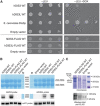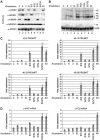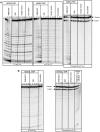The human core exosome interacts with differentially localized processive RNases: hDIS3 and hDIS3L
- PMID: 20531386
- PMCID: PMC2910271
- DOI: 10.1038/emboj.2010.121
The human core exosome interacts with differentially localized processive RNases: hDIS3 and hDIS3L
Abstract
The eukaryotic RNA exosome is a ribonucleolytic complex involved in RNA processing and turnover. It consists of a nine-subunit catalytically inert core that serves a structural function and participates in substrate recognition. Best defined in Saccharomyces cerevisiae, enzymatic activity comes from the associated subunits Dis3p (Rrp44p) and Rrp6p. The former is a nuclear and cytoplasmic RNase II/R-like enzyme, which possesses both processive exo- and endonuclease activities, whereas the latter is a distributive RNase D-like nuclear exonuclease. Although the exosome core is highly conserved, identity and arrangements of its catalytic subunits in different vertebrates remain elusive. Here, we demonstrate the association of two different Dis3p homologs--hDIS3 and hDIS3L--with the human exosome core. Interestingly, these factors display markedly different intracellular localizations: hDIS3 is mainly nuclear, whereas hDIS3L is strictly cytoplasmic. This compartmental distribution reflects the substrate preferences of the complex in vivo. Both hDIS3 and hDIS3L are active exonucleases; however, only hDIS3 has retained endonucleolytic activity. Our data suggest that three different ribonucleases can serve as catalytic subunits for the exosome in human cells.
Conflict of interest statement
The authors declare that they have no conflict of interest.
Figures








Comment in
-
Twins take the job.EMBO J. 2010 Jul 21;29(14):2260-1. doi: 10.1038/emboj.2010.148. EMBO J. 2010. PMID: 20648048 Free PMC article. No abstract available.
References
-
- Bonneau F, Basquin J, Ebert J, Lorentzen E, Conti E (2009) The yeast exosome functions as a macromolecular cage to channel RNA substrates for degradation. Cell 139: 547–559 - PubMed
-
- Bousquet-Antonelli C, Presutti C, Tollervey D (2000) Identification of a regulated pathway for nuclear pre-mRNA turnover. Cell 102: 765–775 - PubMed
Publication types
MeSH terms
Substances
LinkOut - more resources
Full Text Sources
Other Literature Sources
Molecular Biology Databases

